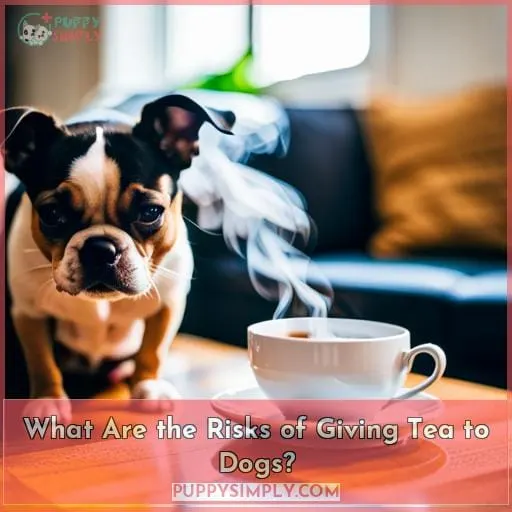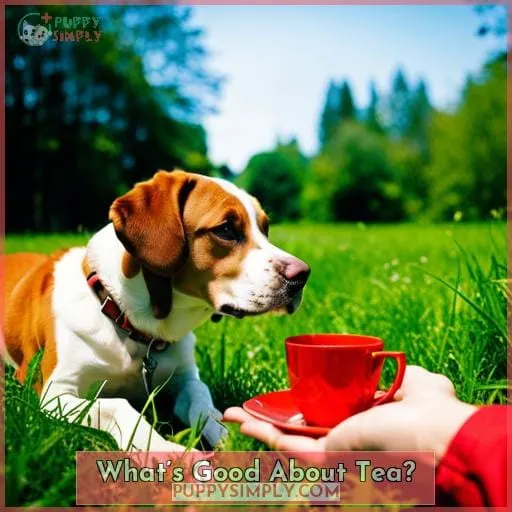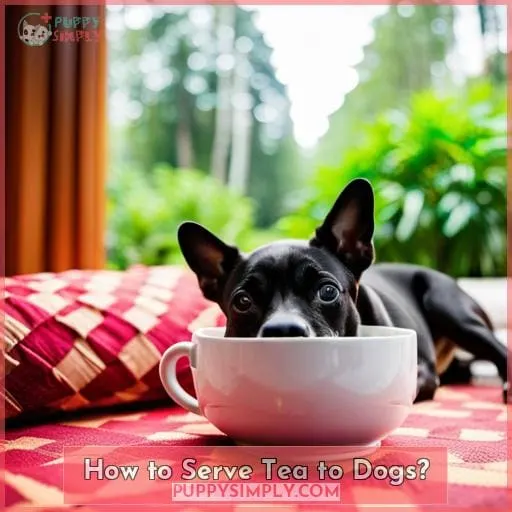This site is supported by our readers. We may earn a commission, at no cost to you, if you purchase through links.
No, dogs should not consume tea. While tea might be an invigorating beverage for humans, it houses caffeine and other substances that can be hazardous to dogs. Tea brings about risks of digestive problems, heightened heart rate, and even caffeine toxicity in dogs.
However, there are a few exceptions – particular herbal teas such as peppermint or chamomile may be harmless to dogs in small quantities. Generally, it’s best to refrain from giving your dog regular tea and instead offer them with safer, dog-friendly choices.
If you desire to delve deeper into which teas are and aren’t safe for your canine companion, continue reading.
Table Of Contents
- Key Takeaways
- Can Dogs Drink Tea?
- Is Tea Bad for Dogs?
- What Are the Risks of Giving Tea to Dogs?
- What’s Good About Tea?
- What Are the Safer Alternatives to Tea for Dogs?
- How to Serve Tea to Dogs?
- How to Make Your Own Homemade Caffeine-free Tea for Dogs
- Can Dogs Drink Herbal Tea?
- Can I Give My Dog Ginger Tea?
- What Are the Signs of Caffeine Toxicity in Dogs?
- Frequently Asked Questions (FAQs)
- Conclusion
Key Takeaways

- Dogs can safely drink tea, but it should be in moderation, and caffeine-free options are best.
- Chamomile and lavender teas have calming effects and can be beneficial for dogs.
- Homemade tea for dogs should use the correct ratio of dried or fresh herbs, and sweeteners like honey should be added after the tea has cooled down.
- Regular teas like green, oolong, or black varieties should be avoided, and always consult with a veterinarian about your dog’s diet and health.
Can Dogs Drink Tea?
You can give your pet a delicious, herbal tea treat – with moderation and the right ingredients – if you follow some simple steps. Can dogs drink tea? The answer is yes, but it must be done safely. Caffeine-free options are best for serving to pets; think decaf or herbal teas like chamomile and lavender which have calming effects on hyperactive or anxious dogs.
When making homemade caffeine-free tea for your dog, you’ll need dried or fresh herbs (or both), depending on what type of blend you wish to create. The primary herb mixed with complementary ones in the correct ratio will do wonders! A tablespoon of dried herb per cup should suffice when using pre-packaged mixes, while two tablespoons per cup is recommended when preparing blends at home.
For iced herbal teas, use up double that amount since cold water extracts less flavor from leaves than boiling does. Then sweeten it up with honey if desired after cooling down appropriately first before serving any kind of prepared beverage (remove all traces such as loose leaves/teabags).
If this sounds complicated, don’t worry. Just experiment until finding something that works well for both parties involved and feel free to share experiences afterwards by writing reviews online where others might also find them useful one day too!
Is Tea Bad for Dogs?
Although tea can be beneficial for your furry friend, it’s important to remember that too much of a good thing isn’t necessarily a good thing. Tea provides calming effects, and caffeine substitutes like decaf or herbal teas, such as chamomile and lavender, have been known to reduce hyperactivity or anxiety in dogs.
When preparing homemade tea for pets, you’ll want to use the right ingredients in the correct ratio. Dried herbs should be around one tablespoon per cup, while two tablespoons are recommended when using fresh herbs.
Make sure sweeteners like honey are added after cooling down appropriately first before serving any kind of prepared beverage (remove all traces such as loose leaves/teabags).
Additionally, peppermint tea has muscle relaxant properties, which makes it a widely used herb among pet owners. However, black tea contains high levels of caffeine, so it must only ever be offered sparingly with caution due to its potential toxicity if consumed excessively by animals.
All in all, though, taking into account moderation plus ensuring appropriate preparation methods when offering any type of caffeinated drink will go a long way towards avoiding harm caused by misusing this drink meant specifically for humans!
What Are the Risks of Giving Tea to Dogs?
It’s essential to remember that overconsumption of tea can be dangerous for your pet, so always serve in moderation. When deciding on the best feeding amounts and types of teas for your pup, it’s important to consider herbal mixtures and sweetening options.
Decaffeinated or herbal teas are preferable as they provide antioxidant properties without the negative side effects associated with caffeine.
Furthermore, some types of herbal teas have been known to help alleviate gastrointestinal disorders in pets as well as providing calming benefits. Chamomile and lavender are two popular choices among pet owners today due to their natural sedative properties.
All in all, though too much tea isn’t recommended since any caffeinated beverage has potential adverse health effects on animals – especially puppies who are more delicate than adults.
What’s Good About Tea?
Tea has many beneficial properties that can help dogs lead healthier lives. It contains antioxidants, anti-inflammatory properties, and other essential minerals. The Camellia sinensis plant is known to have a calming effect on its drinker. It is ideal to serve tea at room temperature for safety reasons.
Herbal teas, like chamomile, are especially popular with pet owners as they help relieve anxiousness in hyperactive dogs while providing overall relaxation benefits. When making homemade recipes, dried herbs are often used, but fresh herbs can be great too! Additionally, sweetening with honey adds some extra flavor.
Just make sure it cools down before consumption so you don’t risk burning their tongues.
For an added treat during summer days, why not try making iced herbal tea? This way, your furry friend will benefit from all of these amazing ingredients without having to worry about any caffeine intake.
Regular teas, such as green, oolong, or black varieties, should be avoided altogether.
Here’s a quick list of the benefits associated with giving tea:
- Antioxidant Properties and Anti-Inflammatory Benefits
- Reduces Stress/Anxiety Levels in Dogs
- Sweetened Honey Adds Flavor
- Iced Tea Option Great for Summer Days
By taking into consideration all the above points when preparing homemade canine recipes involving this beverage, you’ll be able to provide them with safe yet delicious treats they’ll love time after time – no matter what season we’re currently in!
What Are the Safer Alternatives to Tea for Dogs?
For your pup’s safety, consider safer alternatives to tea, such as decaf or herbal options like chamomile and lavender. These provide relaxation benefits for hyperactive or anxious dogs without the risks associated with caffeine intake.
Herbal mixtures can also be made at home using a variety of ingredients. This includes dried herbs like peppermint and rosemary, fresh plants such as thyme or oregano, and sweetening options like honey for added flavor.
Additionally, iced teas are great refreshers on hot summer days. Just make sure they cool down before serving them to your pet.
It’s always important to consult with a veterinarian about what is best for your dog when it comes to their diet. This includes providing plenty of fresh water in addition to other nutritious foods that might be recommended by experts in canine health care.
Tea offers many beneficial properties, but if you’re ever unsure about its suitability, please seek veterinary advice first.
How to Serve Tea to Dogs?
Serving tea to your pup is a fun and tasty way to show them some love, but there are a few important steps you need to take before they can enjoy their cup.
First of all, consider which type of tea you’d like for your pooch. Herbal teas like chamomile and lavender are usually safer than black or green teas that contain naturally-occurring caffeine. You can also make homemade iced or hot beverages with fresh herbs such as peppermint or thyme if desired.
Next up is understanding the brewing process. Use freshly boiled water at room temperature so it won’t harm your pup when served (not too hot!). Then add one teaspoon of dried herb per cup of liquid along with any additional flavoring ingredients before letting steep for 8-10 minutes in order to extract the beneficial properties from each plant.
Be sure not to leave longer because this will create higher levels of free radicals in the beverage.
Finally, strain out any remaining solids into another container and let cool down completely prior to offering it up for consumption. Ideally, wait until lukewarm so that no burns occur due to mouth contact! Lastly, don’t forget about removing used bags after steeping since these still retain small amounts of caffeine even though most has been extracted during the boiling stage.
To reap the full benefit from serving tea to dogs, it’s best to utilize a combination of different types to combine effects together and help achieve the desired outcome, such as calming an anxious dog or freshening breath.
Additionally, always keep moderation in mind. Depending on the size and breed, tea should never exceed 1/4th cup twice a day maximum to ensure a healthy life balance overall.
As mentioned earlier, honey is a great alternative to traditional sugar to increase palatability further. However, please consult a veterinarian for advice first to see what best fits the needs of your pup.
How to Make Your Own Homemade Caffeine-free Tea for Dogs
Making your own caffeine-free tea for your pup can be a fun and rewarding experience. It’s important to understand the role of herbal ratios, sweeteners, iced teas, and cooling times to ensure that you get the best possible results from each cup.
Here is a good rule of thumb: use one teaspoon of dried herb per cup when pre-prepared tea bags are not available or desired. Fresh herbs can also be used in place of dried ones but should follow this ratio as well for optimal health benefits.
Additionally, using honey instead of sugar has an added benefit – it helps reduce inflammation, which is especially helpful if dealing with any allergies or sensitivities in dogs!
Finally, make sure that all brewed liquids are strained properly before giving them to your fur baby so they don’t ingest any loose particles from leftover plant material.
Overall, making homemade caffeine-free tea for dogs provides a useful prescription-free alternative while still delivering on its calming effects due to natural ingredients like chamomile and lavender often found within these mixtures too!
Can Dogs Drink Herbal Tea?
Are you wondering if it’s safe for your pup to drink herbal tea? You’re in luck! There are a few varieties of soothing and calming teas that are great for dogs. Peppermint tea is known to help with digestion, while chamomile has calming properties that can be helpful for hyperactive or anxious pooches.
Just remember: moderation is key when it comes to giving your dog any type of beverage.
Peppermint Tea for Dogs
A refreshing cup of peppermint tea can be an energizing treat for your pup, with natural calming agents like chamomile and lavender blended in. The Camellia sinensis plant is the base ingredient for most types of tea that help reduce smooth muscle spasms, feelings of nausea, and indigestion.
When it comes to feeding tips for dogs drinking herbal teas – moderation should always be key! An occasional cup when mixed into their regular diet may even provide benefits such as relief from stress or anxiety depending on the specific blend chosen.
A suitable choice might include a caffeine-free mix made up primarily of peppermint along with complementary herbs like chamomile or lavender.
Iced teas are also great options during hot summer days, but remember to let them cool down before serving it to your furry friend so they don’t burn their tongues! As long as you stick within these guidelines and use honey instead of sugar – there’s no reason why this delicious beverage can’t become part of your pet’s daily routine too!
Chamomile Tea for Dogs
Chamomile tea is a great choice for your pup, offering natural calming agents to help reduce stress or anxiety.
Herbal mixtures can be used when preparing tea for dogs. They should include one teaspoon of the dried herb mixture per cup.
Iced teas with sweetening options like honey are also available. They make perfect post-workout drinks on hot summer days!
If you have a pet cocker spaniel, they may particularly enjoy this beverage. It’s one of the most consumed dishes in many cuisines around the world.
Be sure to let your pup’s drink cool before serving so they don’t burn their tongues!
With these tips in mind, there’s no doubt that chamomile tea can become part of your pet’s daily routine too!
Can I Give My Dog Ginger Tea?
Transition: If you find that herbal tea is beneficial for your pup, then ginger tea may also be worth exploring. Now let’s discuss the calming benefits of ginger and the safety of giving it to dogs in a cup of tea.
Ginger has been used as an herb for centuries due to its medicinal properties. It can help with digestion, reduce inflammation, and provide natural relief from certain types of pain or nausea—all great reasons why some pet parents might consider adding it into their canine companion’s diet!
When opting for ginger root teas specifically designed for pets (which are commercially available), make sure you follow dosage instructions carefully; too much could potentially cause side effects such as vomiting or diarrhea in some animals.
As an alternative option, many people choose to make homemade ginger-based teas instead by combining fresh or dried herbs like chamomile flowers with freshly grated pieces of peeled root. The ratio should be 1 part primary herb (like sage) to 3 parts complementary herbs (such as lavender).
Boil this mixture on low heat until both ingredients have released their flavor completely before straining off all liquid through cheesecloth or a sieve into a mug or tumbler. Add honey if desired, and let it cool down properly before serving to avoid harming your dog’s body temperature-wise.
The final product will typically have a natural green color but no caffeine boost, which can sometimes be sought after when brewing regular black or green varieties. However, what makes this type unique compared to other forms is that while they offer additional antioxidant protection against free radicals, there remains one main issue: namely, how much actual flavor comes out once boiled? Therein lies the question of whether what we perceive tastes nice would actually taste good enough even with just half a teaspoon stirred within a glassful of hot water.
In any case, being mindful and making sure doses remain small while still providing canine companionship something soothing or comforting drink-wise never hurts.
What Are the Signs of Caffeine Toxicity in Dogs?
Though moderation is key, you may find that ginger tea can be beneficial to your pup’s well-being – but it pays to be aware of the signs of caffeine toxicity in case too much is consumed.
Caffeine overdose can occur when a dog has ingested large amounts of tea or coffee-based beverages, energy drinks, certain types of chocolate, or even some over-the-counter medications containing stimulants such as guarana and ma huang.
Common symptoms include restlessness due to an increased heart rate and hyperactivity, trembling, and vomiting. In severe cases, it can lead to seizures or death if not treated immediately by a veterinarian professional who will administer drugs designed specifically for this purpose in order to repair any damage caused by the caffeine overload.
They may also give medication that helps with upset stomachs due to its diuretic effects on animals’ digestive system.
When brewing homemade teas with similar properties like our canine companions’ favorite fragrant addition—ginger root—it’s important not only to pay attention during preparation but also to make sure dosages remain small so as not to exceed daily suggested limits (which vary depending on breed size).
Sweeteners should always be omitted from any type being given directly since artificial ones have been linked as one of the main causes of caffeine toxicity among pets before, regardless of their individual weight classifications.
And lastly, never forget to let it cool down completely after the boiling process prior to serving anything whatsoever, flasks, cups alike, just to ensure everyone remains safe and sound throughout the entire duration!
Frequently Asked Questions (FAQs)
How much tea can a dog safely drink?
Dogs can have a cup of tea every now and then, but moderation is key. A good rule of thumb is to consider what amount would be appropriate for their size; too much can be harmful.
Can puppies drink tea?
Puppies can have herbal tea, but in moderation. Chamomile and lavender are particularly helpful for those that may be anxious or hyperactive. Use fresh or dried herbs – just remember to remove the tea bag before serving! Make sure it’s cooled down first too, and you might want to add a little honey for sweetness.
Are there any side effects of giving tea to dogs?
Yes, there can be side effects if tea is given to dogs in excess. Too much caffeine or other ingredients may cause nervousness and digestive issues – not pleasant for your pup! Moderation is key when it comes to giving any type of tea to your furry friend.
Is it safe to give tea to a pregnant dog?
It is generally not recommended to give tea to pregnant dogs due to the potential side effects. Instead, consult a veterinarian for guidance on how to best care for your expectant pup.
Is there a way to make the tea more appealing to a dog?
Try sweetening the tea with honey or adding fresh herbs like chamomile and lavender to make it more appealing to your dog.
Conclusion
In conclusion, it’s important to remember that tea can be a great source of nourishment and relaxation for dogs, as long as it’s given in moderation.
For a safe and healthy alternative, you can make your own homemade caffeine-free teas with dried or fresh herbs. With the right ingredients and techniques, you can brew a delicious cup of tea that your pup can enjoy without any worries.
Just like a piece of cake, giving your pup tea can be a fun and rewarding experience, as long as you take the necessary precautions.















